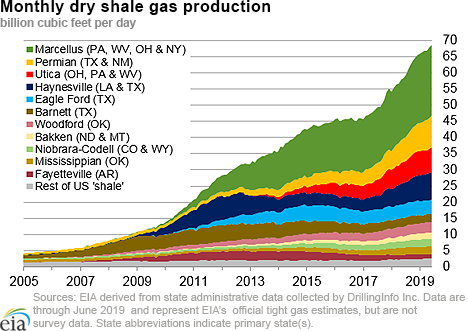In the News:
Big Bend Power Station to increase Florida’s natural gas-fired generation capacity
On July 25, 2019, Tampa Electric (TECO) announced that the Big Bend Power Station Modernization Project received final approval. This approval includes converting a coal-fired electric generator unit to natural gas, and retiring a second coal-fired unit. According to EIA’s Monthly Update to Annual Electric Generator Report, the Big Bend Modernization Project will account for 84% of the 937 megawatts (MW) of natural gas-fired planned capacity additions in Florida through 2021. The project will increase net generation capacity at the Big Bend Power Station when the combined-cycle unit begins operations in 2023.
The 1.7 gigawatt (GW) Big Bend Power Station currently includes four coal-fired units (Units 1–4), constructed between 1970 and 1985, as well as a dual-fuel unit (Unit 5), constructed in 2009, which is capable of consuming natural gas or fuel oil. The dual-fuel unit is dispatched during times of peak demand, typically in the summer when demand for air conditioning is at its highest. TECO installed a 19 MW solar photovoltaic project at the site in 2017.
The Big Bend Modernization Project will convert Unit 1 into a natural gas combined-cycle unit. The new unit will consist of two new combustion turbine generators—rated at 370 MW each—and an existing steam turbine generator, bringing Unit 1 total nominal generating capacity to more than 1 GW. Before the Unit 1 conversion occurs, the project will retire Big Bend’s Unit 2 coal-fired unit and upgrade the facility to receive pipeline natural gas as feedstock for electricity generation. Unit 1 will begin simple-cycle operations in 2021, and combined-cycle operations will start in 2023, according to project plans.
Between 2008 and 2018, Florida led the United States in natural gas capacity additions in the electric power sector, adding 15.7 GW of natural-gas fired electric generation capacity. These additions have more than offset retirements of conventional coal-fired units (2.8 GW), petroleum liquids-fired units (5.1 GW), and less-efficient natural gas-fired units (3.3 GW). In addition to natural gas capacity additions in Florida, pipeline infrastructure has been growing throughout the region, according to EIA’s pipeline projects database.
In 2007, Florida adopted an environmental standard that aims to reduce power sector greenhouse gas emissions to 1990 levels by 2025. The Big Bend project continues the state’s transition away from petroleum liquids and coal sources of electricity generation in favor of cleaner, more cost-competitive sources such as natural gas and solar. Once complete, TECO expects the Big Bend project will reduce greenhouse gas emissions by approximately 3 million tons of carbon dioxide per year.
Overview:
(For the week ending Wednesday, August 7, 2019)
- Natural gas spot prices fell at most locations this report week (Wednesday, July 31 to Wednesday, August 7). Henry Hub spot prices fell from $2.23 per million British thermal units (MMBtu) last Wednesday to $2.12/MMBtu yesterday.
- At the New York Mercantile Exchange (Nymex), the price of the September 2019 contract decreased 15¢, from $2.233/MMBtu last Wednesday to $2.083/MMBtu yesterday. The price of the 12-month strip averaging September 2019 through August 2020 futures contracts declined 12¢/MMBtu to $2.304/MMBtu.
- Net injections to working gas totaled 55 billion cubic feet (Bcf) for the week ending August 2. Working natural gas stocks are 2,689 Bcf, which is 15% more than the year-ago level and 4% lower than the five-year (2014–18) average for this week.
- The natural gas plant liquids composite price at Mont Belvieu, Texas, rose by 32¢/MMBtu, averaging $4.39/MMBtu for the week ending August 7. The price of natural gasoline fell by 1%. The price of ethane, butane, and propane rose by 25%, 16%, and 9%, respectively. The price of isobutane remained flat week over week.
- According to Baker Hughes, for the week ending Tuesday, July 30, the natural gas rig count increased by 2 to 171. The number of oil-directed rigs fell by 6 to 770. The total rig count decreased by 4, and it now stands at 942.
Prices/Supply/Demand:
Prices fall across the country with mild summer weather. This report week (Wednesday, July 31 to Wednesday, August 7), Henry Hub spot prices fell 11¢ from $2.23/MMBtu last Wednesday to $2.12/MMBtu yesterday, with a low of $2.03/MMBtu on Monday. Temperatures were slightly cooler than normal east of the Rockies and slightly warmer than normal west of the Rockies and across the Great Plains. At the Chicago Citygate, prices decreased 5¢ from $2.08/MMBtu last Wednesday to $2.03/MMBtu yesterday.
California prices rank among the highest in the Lower 48 states this summer. Prices at PG&E Citygate in Northern California fell 20¢, down from a high of $2.73/MMBtu last Wednesday to $2.53/MMBtu yesterday. Prices at SoCal Citygate increased 7¢ from $2.95/MMBtu last Wednesday to $3.02/MMBtu yesterday. According to Natural Gas Intelligence, California has the second-highest prices of any region in the Lower 48 states this summer, only exceeded by natural gas import prices at the Canadian border.
Northeast prices fall. Northeast temperatures were slightly cooler than normal, moderating cooling demand. At the Algonquin Citygate, which serves Boston-area consumers, prices went down 17¢ from $2.22/MMBtu last Wednesday to $2.05/MMBtu yesterday, with a low of $1.85/MMBtu on Monday. At the Transcontinental Pipeline Zone 6 trading point for New York City, prices decreased 9¢ from $2.16/MMBtu last Wednesday to $2.07/MMBtu yesterday, with a low of $1.92/MMBtu set on Monday.
Tennessee Zone 4 Marcellus spot prices decreased 8¢ from $1.86/MMBtu last Wednesday to $1.78/MMBtu yesterday. Prices at Dominion South in southwest Pennsylvania fell 6¢ from $1.94/MMBtu last Wednesday to $1.88/MMBtu yesterday.
Permian Basin prices decline throughout the week. Prices at the Waha Hub in West Texas, which is located near Permian Basin production activities, averaged a weekly high of $0.21/MMBtu last Wednesday, $2.02/MMBtu lower than Henry Hub prices. Yesterday, prices at the Waha Hub averaged a weekly low of -$0.03/MMBtu, $2.15/MMBtu lower than Henry Hub prices, as a result of production that outpaced demand.
Supply rises with record-high dry natural gas production. According to data from PointLogic Energy, the average total supply of natural gas rose by 1% compared with the previous report week. Dry natural gas production grew by 1% compared with the previous report week, reaching an all-time high of 92.1 billion cubic feet per day (Bcf/d) on Monday, the first time dry gas production has surpassed 92 Bcf/d. Average net imports from Canada decreased by 9% from last week.
Demand rises and power burn reaches a record high. Total U.S. consumption of natural gas rose by 1% compared with the previous report week, according to data from PointLogic Energy. Natural gas consumed for power generation climbed by 3% week over week, reaching an all-time high of 44.4 Bcf/d yesterday. Industrial sector consumption decreased by 2% week over week. In the residential and commercial sectors, consumption increased by 4%. Natural gas exports to Mexico increased 1%.
U.S. LNG exports decrease week over week. Eight liquefied natural gas (LNG) vessels (five from Sabine Pass, and one each from the Cove Point, Corpus Christi, and Cameron LNG export terminals) with a combined LNG-carrying capacity of 29 Bcf departed the United States between August 1 and August 7, according to shipping data compiled by Bloomberg. One vessel was loading at the Sabine Pass and one at the Corpus Christi terminals on Wednesday.
Natural gas feedstock deliveries to U.S. LNG export facilities have averaged 4.7 Bcf/d during the report week (August 1–7), a 1.3 Bcf/d decrease from the previous week as a result of several trains that have started scheduled maintenance. Sabine Pass has shut down Trains 3 and 4 for maintenance, and currently only Trains 1, 2, and 5 are operating, according to OPIS PointLogic Energy. Feedstock deliveries to Freeport LNG have also decreased by 50% during this report week compared with the previous week because of testing on Train 2. The first LNG production from Train 1 at Freeport LNG is expected in September 2019.
Storage:
Net injections into storage totaled 55 Bcf for the week ending August 2, compared with the five-year (2014–18) average net injections of 43 Bcf and last year's net injections of 46 Bcf during the same week. Working gas stocks totaled 2,689 Bcf, which is 111 Bcf lower than the five-year average and 343 Bcf more than last year at this time.
According to The Desk survey of natural gas analysts, estimates of the weekly net change from working natural gas stocks ranged from net injections of 55 Bcf to 67 Bcf, with a median estimate of 59 Bcf.
The average rate of net injections into storage is 33% higher than the five-year average so far in the refill season (April through October). If the rate of injections into storage matched the five-year average of 9.9 Bcf/d for the remainder of the refill season, total inventories would be 3,581 Bcf on October 31, which is 111 Bcf lower than the five-year average of 3,692 Bcf for that time of year.
More storage data and analysis can be found on the Natural Gas Storage Dashboard and the Weekly Natural Gas Storage Report.
See also:
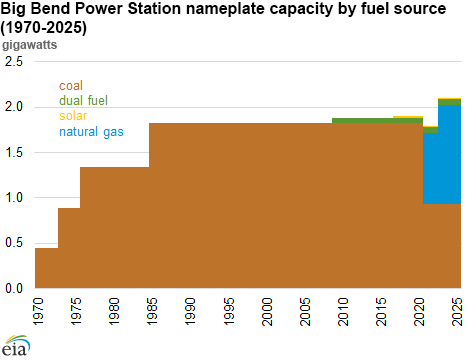 Sources: U.S. Energy Information Administration, Tempa Electric and Preliminary Electric Generator Inventory
Sources: U.S. Energy Information Administration, Tempa Electric and Preliminary Electric Generator Inventory
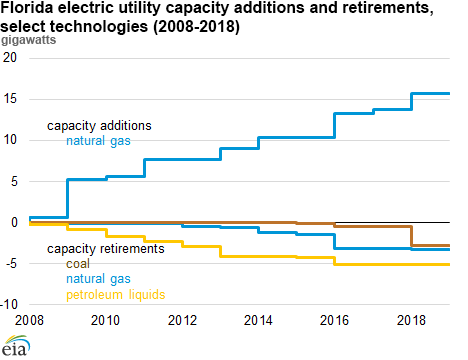 Source: U.S. Energy Information Administration, Preliminary Electric Generator Inventory
Source: U.S. Energy Information Administration, Preliminary Electric Generator Inventory
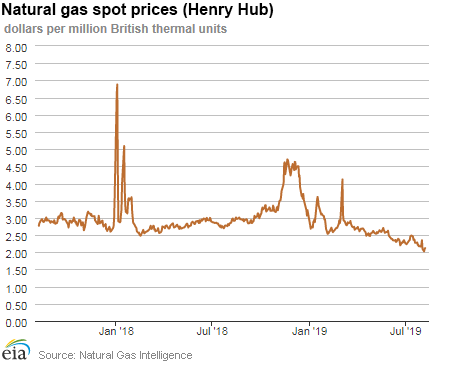
| Spot Prices ($/MMBtu) | Thu, 01-Aug |
Fri, 02-Aug |
Mon, 05-Aug |
Tue, 06-Aug |
Wed, 07-Aug |
|---|---|---|---|---|---|
| Henry Hub |
2.35 |
2.10 |
2.03 |
2.10 |
2.12 |
| New York |
2.08 |
1.92 |
2.08 |
2.17 |
2.07 |
| Chicago |
2.11 |
1.90 |
1.91 |
2.05 |
2.03 |
| Cal. Comp. Avg.* |
2.40 |
2.18 |
2.37 |
2.48 |
2.35 |
| Futures ($/MMBtu) | |||||
| September contract | 2.202 |
2.121 |
2.070 |
2.111 |
2.083 |
| October contract |
2.212 |
2.130 |
2.083 |
2.124 |
2.099 |
| *Avg. of NGI's reported prices for: Malin, PG&E Citygate, and Southern California Border Avg. | |||||
| Sources: Natural Gas Intelligence and CME Group as compiled by Bloomberg, L.P. | |||||
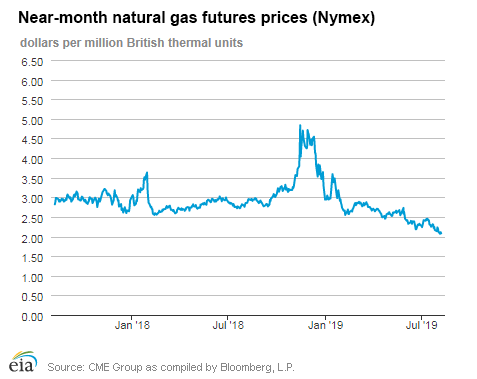
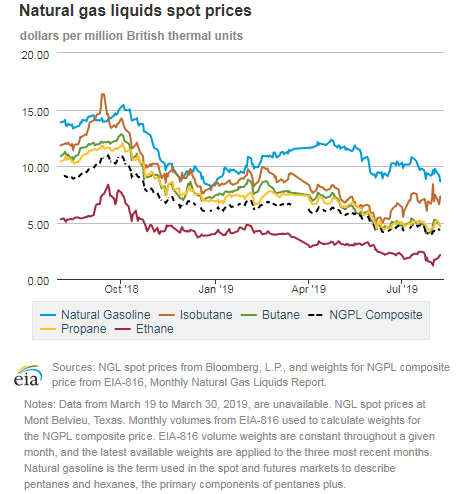
| U.S. natural gas supply - Gas Week: (8/1/19 - 8/7/19) | |||
|---|---|---|---|
Average daily values (Bcf/d): |
|||
this week |
last week |
last year |
|
| Marketed production | 102.3 |
101.2 |
93.1 |
| Dry production | 91.4 |
90.5 |
83.5 |
| Net Canada imports | 4.4 |
4.9 |
5.3 |
| LNG pipeline deliveries | 0.1 |
0.1 |
0.1 |
| Total supply | 95.9 |
95.5 |
88.9 |
|
Source: OPIS PointLogic Energy, an IHS Company | |||
| U.S. natural gas consumption - Gas Week: (8/1/19 - 8/7/19) | |||
|---|---|---|---|
Average daily values (Bcf/d): |
|||
this week |
last week |
last year |
|
| U.S. consumption | 70.8 |
69.8 |
68.2 |
| Power | 41.2 |
40.1 |
38.9 |
| Industrial | 21.2 |
21.6 |
21.6 |
| Residential/commercial | 8.3 |
8.0 |
7.7 |
| Mexico exports | 5.0 |
4.9 |
4.9 |
| Pipeline fuel use/losses | 6.4 |
6.3 |
6.0 |
| LNG pipeline receipts | 4.7 |
6.0 |
3.4 |
| Total demand | 86.9 |
87.0 |
82.5 |
|
Source: OPIS PointLogic Energy, an IHS Company | |||
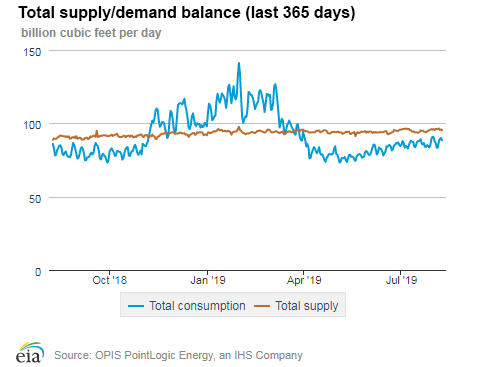
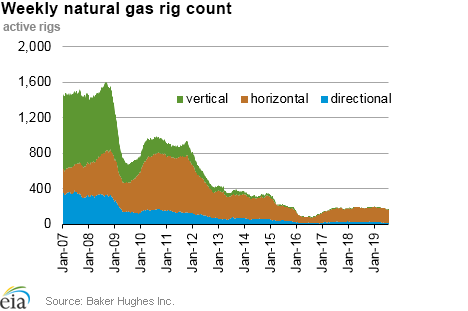
| Rigs | |||
|---|---|---|---|
Tue, July 30, 2019 |
Change from |
||
last week |
last year |
||
| Oil rigs | 770 |
-0.8% |
-10.4% |
| Natural gas rigs | 171 |
1.2% |
-6.6% |
| Note: Excludes any miscellaneous rigs | |||
| Rig numbers by type | |||
|---|---|---|---|
Tue, July 30, 2019 |
Change from |
||
last week |
last year |
||
| Vertical | 1 |
0.0% |
0.0% |
| Horizontal | 16 |
14.3% |
-36.0% |
| Directional | 67 |
0.0% |
4.7% |
| Source: Baker Hughes Inc. | |||
| Working gas in underground storage | ||||
|---|---|---|---|---|
Stocks billion cubic feet (Bcf) |
||||
| Region | 2019-08-02 |
2019-07-26 |
change |
|
| East | 613 |
597 |
16 |
|
| Midwest | 701 |
677 |
24 |
|
| Mountain | 161 |
156 |
5 |
|
| Pacific | 272 |
270 |
2 |
|
| South Central | 941 |
934 |
7 |
|
| Total | 2,689 |
2,634 |
55 |
|
|
Source: Form EIA-912, Weekly Underground Natural Gas Storage Report | ||||
| Working gas in underground storage | |||||
|---|---|---|---|---|---|
Historical comparisons |
|||||
Year ago (8/2/18) |
5-year average (2014-2018) |
||||
| Region | Stocks (Bcf) |
% change |
Stocks (Bcf) |
% change |
|
| East | 571 |
7.4 |
646 |
-5.1 |
|
| Midwest | 576 |
21.7 |
700 |
0.1 |
|
| Mountain | 148 |
8.8 |
177 |
-9.0 |
|
| Pacific | 245 |
11.0 |
293 |
-7.2 |
|
| South Central | 808 |
16.5 |
984 |
-4.4 |
|
| Total | 2,346 |
14.6 |
2,800 |
-4.0 |
|
| Source: Form EIA-912, Weekly Underground Natural Gas Storage Report | |||||
| Temperature – heating & cooling degree days (week ending Aug 01) | ||||||||
|---|---|---|---|---|---|---|---|---|
HDD deviation from: |
CDD deviation from: |
|||||||
| Region | HDD Current |
normal |
last year |
CDD Current |
normal |
last year |
||
| New England | 0 |
-2 |
0 |
73 |
28 |
12 |
||
| Middle Atlantic | 0 |
-3 |
-1 |
80 |
21 |
16 |
||
| E N Central | 2 |
-2 |
-4 |
61 |
4 |
27 |
||
| W N Central | 2 |
-1 |
-3 |
61 |
-10 |
22 |
||
| South Atlantic | 0 |
0 |
0 |
97 |
0 |
2 |
||
| E S Central | 0 |
0 |
0 |
84 |
-11 |
3 |
||
| W S Central | 0 |
0 |
0 |
122 |
-4 |
-4 |
||
| Mountain | 0 |
-3 |
-1 |
94 |
15 |
-2 |
||
| Pacific | 0 |
-2 |
0 |
67 |
19 |
-20 |
||
| United States | 1 |
-2 |
-1 |
82 |
7 |
6 |
||
|
Note: HDD = heating degree day; CDD = cooling degree day Source: National Oceanic and Atmospheric Administration | ||||||||
Average temperature (°F)
7-day mean ending Aug 01, 2019
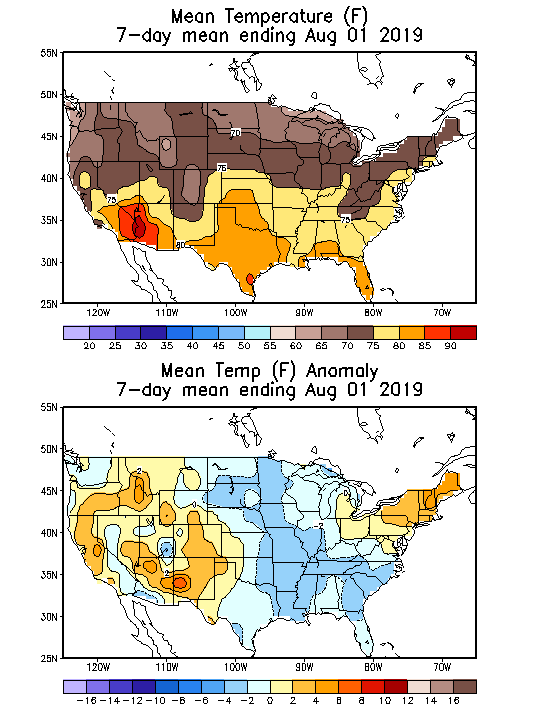
Source: National Oceanic and Atmospheric Administration
Deviation between average and normal (°F)
7-day mean ending Aug 01, 2019

Source: National Oceanic and Atmospheric Administration

